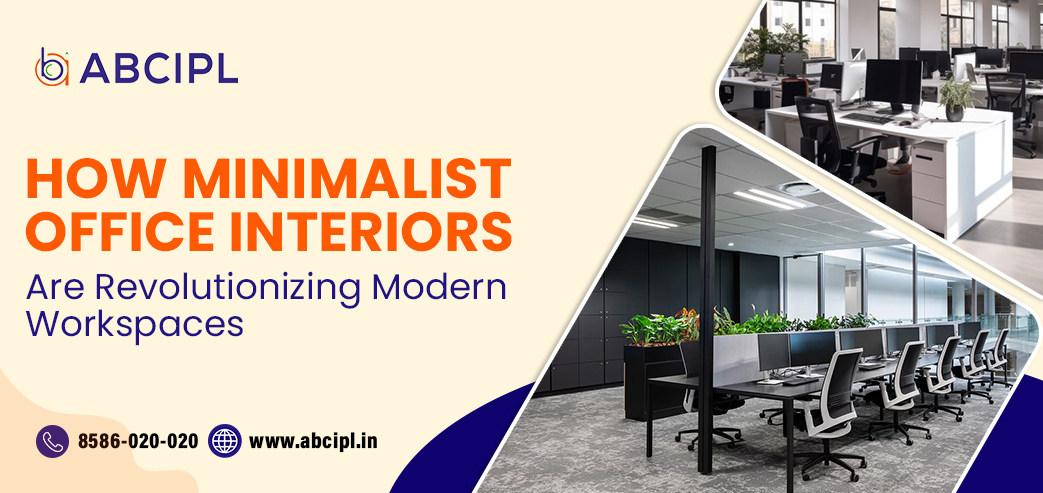
How Minimalist Office Interiors Are Revolutionizing Modern Workspaces
In today’s fast-paced world, where efficiency and productivity are paramount, minimalist office interiors are gaining immense popularity. This design approach prioritizes simplicity, functionality, and aesthetics, creating a workspace that fosters focus and creativity. Let’s explore how minimalist interiors are transforming modern work environments.
What Are Minimalist Office Interiors?
Minimalist office interiors are characterized by clean lines, open spaces, and a clutter-free environment. This design philosophy emphasizes:
Simplicity: Using only essential furniture and decor.
Neutral Colors: Shades like white, grey, and beige dominate the palette.
Functional Design: Every element serves a purpose without unnecessary embellishments.
This approach creates a calm and organized workspace that reduces stress and distractions.
The Key Elements of Minimalist Office Interiors
Minimalist office interiors focus on integrating certain key elements:
Decluttered Spaces: Unnecessary items are eliminated to maintain a clean environment.
Natural Light: Large windows and open layouts allow ample daylight to flood the workspace.
Ergonomic Furniture: Sleek, functional furniture ensures comfort and productivity.
Subtle Decor: Art pieces, indoor plants, or textured walls add character without overpowering the space.
Technology Integration: Concealed wiring and modern gadgets blend seamlessly into the design.
Benefits of Minimalist Office Interiors
Adopting minimalist interiors offers several advantages for employees and organizations alike:
1. Enhanced Productivity
A clutter-free environment reduces distractions, allowing employees to focus better on their tasks. The simplicity of the design encourages a clear mindset, boosting overall productivity.
2. Improved Mental Well-being
Minimalist spaces create a calming atmosphere that alleviates stress. Neutral tones and open layouts contribute to a sense of serenity, promoting mental well-being.
3. Cost Efficiency
Minimalist interiors often require fewer materials and decorations, resulting in lower setup and maintenance costs. Investing in high-quality, functional furniture also reduces long-term expenses.
4. Eco-Friendly Design
Sustainable materials and energy-efficient lighting are common in minimalist offices, supporting environmental goals and reducing carbon footprints.
5. Enhanced Collaboration
Open and airy layouts encourage communication and collaboration among team members, fostering a more cohesive work environment.
How Minimalist Interiors Are Revolutionizing Modern Workspaces
The shift towards minimalist design is reshaping how we perceive and use office spaces. Here’s how:
1. Flexible Workstations
Minimalist interiors incorporate modular furniture and open layouts, making it easier to reconfigure spaces as needed. This flexibility supports hybrid work models and agile team setups.
2. Focus on Employee Comfort
Ergonomic chairs, adjustable desks, and optimized lighting ensure employees are comfortable throughout the day. This focus on well-being enhances job satisfaction and retention.
3. Technology Integration
Modern minimalist offices seamlessly integrate technology, from smart boards to wireless charging stations, creating a future-ready workspace.
4. Aesthetic Appeal
The clean and organized look of minimalist offices leaves a lasting impression on clients and visitors, enhancing the company’s brand image.
Practical Tips for Designing a Minimalist Office
If you’re considering a minimalist makeover for your office, here are some tips:
Prioritize Functionality: Choose multi-purpose furniture that saves space and serves various needs.
Use Neutral Colors: Opt for shades that create a soothing environment, like white or pastel hues.
Declutter Regularly: Maintain a clean workspace by organizing files and removing unnecessary items.
Incorporate Nature: Add indoor plants for a touch of greenery and improved air quality.
Focus on Lighting: Maximize natural light and use LED fixtures for energy efficiency.
Real-Life Examples of Minimalist Office Interiors
1. Google’s Zurich Office
Known for its innovative designs, Google’s Zurich office incorporates minimalist elements with functional spaces and modern decor.
2. Apple Headquarters
Apple’s iconic offices are a testament to minimalist design, featuring sleek furniture, open layouts, and cutting-edge technology.
3. WeWork Spaces
WeWork’s co-working spaces embrace minimalist principles, offering clean and versatile work environments for individuals and teams.
Conclusion
Minimalist office interiors are more than just a design trend—they represent a shift towards smarter, more efficient workspaces. By prioritizing simplicity, functionality, and employee well-being, minimalist designs revolutionize the way we work. Whether you’re redesigning your office or setting up a new workspace, embracing minimalism can pave the way for a productive and inspiring environment.